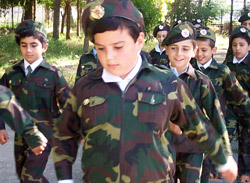Children at School No. 99 in Yerevan undergoing military drill as part of their education. Photographs by Gegham Vardanian.
“Right turn! Left shoulder forward! Quick march!” shouts military training instructor Karo Ambardzumian, although his subordinates are not soldiers but 11- and 12-year-old children at a school in the Armenian capital Yerevan.
Although military training is compulsory for pupils aged 16 to 18 in Armenia, only School No. 99 has introduced it for younger children. Groups involved in children’s rights are worried about the effect an early dose of militarism will have on young minds, not least because the 11 other schools where the government now plans to roll out a similar pilot scheme cater for children from vulnerable backgrounds.
Headmistress Ludmila Margarian originally introduced the weekly military classes as a way of bringing a group of unruly boys to heel.
“There were many boys in this class. We thought they lacked discipline and decided to make it a class with a military bias,” she said. “When they’re in uniform, they are more organised and have a greater sense of responsibility.”
The 18 boys and eight girls in the class have learnt how to march, stand in formation and dismantle Kalashnikov assault rifles, and are now learning combat skills.
“We are studying military science,” said Sarkis, 11. “We learn how to crawl round enemies and kill them.”
Sarkis’s grandmother Susanna Martirossian said parents had heartily welcomed the scheme. “My grandson is delighted,” she said. “He knows that he’s going to be a general, that he’s a military man. We are happy too, because he’s learning what a soldier’s responsibilities are, he feels like a soldier and wants to pursue an army career.”
Hranush, wearing her uniform and with her hair tucked under a camouflage cap, said, “The boys come to school in uniform, and so do we. It isn’t bad. We are learning how to help our homeland when the need arises.”
Another girl, Aelita, added, “We’ve learnt how to handle a machine-gun, and studied some aspects of military strategy, tactics, and ways of surrounding and defeating an enemy.
“I’d say the girls are treated more leniently than the boys, and they get good marks more easily.”
The school’s military instructor Karo Ambardzumian, a former paratrooper and Soviet frontier guard, says it is best to start as young as possible, “It’s difficult to train grown-ups. A child is like unbaked dough, and you should teach them things from a very early age.”
“I always dreamed of creating such a class,” said Ambardzumian. “As the saying goes, if you want peace, prepare for war. I try to explain to them who will defend our motherland from, and how. Children learn all these things when they dismantle or assemble a gun.”
School No. 99 is located in a poor area on the outskirts of Yerevan, serving a community in which many pupils come from one-parent families.
Mikael Danielian, who chairs the Helsinki Association human rights group, is disappointed if not surprised by the trend, given that Armenia sees itself as being on a war footing since the dispute with Azerbaijan over Nagorny Karabakh remains unresolved.
“If children and their parents see no reason to complain and they’re prepared to accept the rules of the game, then there’s no big violation of rights,” he said. “But it’s bad that the country is being built by soldiers. This is a country where young people are soldiers; such a thing was only possible in the Soviet Union or in an Islamic country.”
The education ministry seems pleased with the programme at School No. 99, and plans to expand the scheme by making military training a core curriculum item in 11 schools across Armenia.
The ministry has selected “special schools” – whose pupils mostly come from difficult backgrounds – to take part in the project.
“Our basic aim is to gather children from the streets who for one reason or another don’t attend school regularly, and who want to enter military college but have never had the chance, and enable them to study military matters in depth,” said Vachagan Aslanian, a specialist on military training at the National Institute of Education.
“In future, all classes [at the 11 schools] will take intensive military training courses,” said Aslanian. “Each school will cater for one district. Pupils from elsewhere who want to get intensive military training will be allowed to transfer to these schools.”
Aslanian said parental permission would always be sought before putting children into military training.
Critics of the military classes remain unhappy about the scheme despite such assurances.
“I can see what’s going on,” said Danielian. “These are difficult children who spend a lot of time on the street, and they are being turned into military types. This is an old Soviet-era method.”
Emil Saakian, public relations coordinator for UNICEF in Armenia, went further, pointing out, “Article Four of the Armenian children’s rights law is being violated, which says children have equal rights. Children who for some reason end up at special schools are being pressured to follow a military path. A child’s right to choose his own future is being abused.”
Saakian went on, “Children’s… future is being determined by someone else…. I understand the country needs good soldiers, but it also needs good scientists, doctors and other specialists. Who says that soldiers alone are needed to keep the country safe, and that other professionals don’t contribute to defending the country?”
Meanwhile, the schoolchildren have found an immediate and practical application for their new battlefield skills.
“The military training lessons help us when we have fights with other classes,” explained schoolboy Varazdat. “We even have scraps with older pupils, and we can help out our own guys.”

